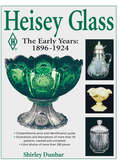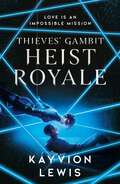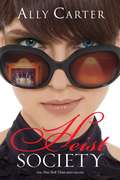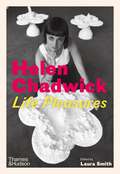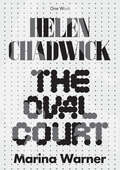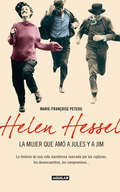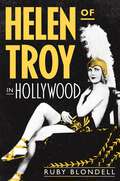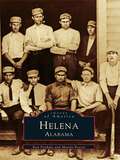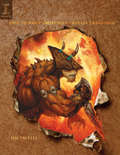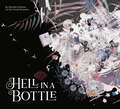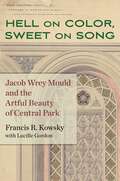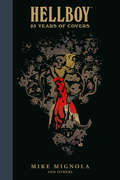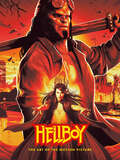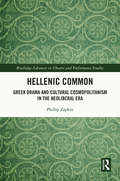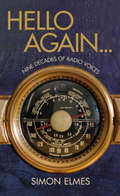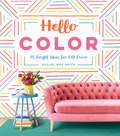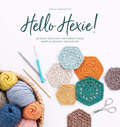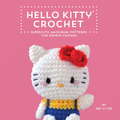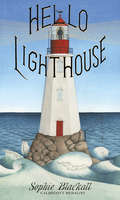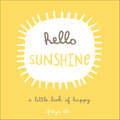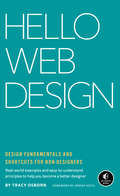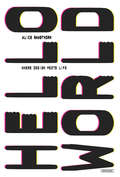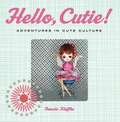- Table View
- List View
Heisey Glassware: The Early Years: 1896-1924
by DunbarIDENTIFY AND PRICEMarked and unmarked pieces of Heisey collectible glass.This first-ever comprehensive guide to Heisey glassware covers the early production years of the A.H. Heisey Company - from 1896 through 1924 - and offers accurate, comprehensive, detailed information regarding patterns and colors, production dates and values. Know your glass, and you'll feel confident buying, selling and collecting Heisey glassware. • Explores the history, rise and fall of the A.H. Heisey Company • Identifies all early patterns produced from 1896-1924 • Includes color photos and pattern descriptions • Provides up-to-date market values • Offers tips on buying and caring for glassware
Heist Royale: The enemies to lovers sequel to Waterstones prize-winning Thieves' Gambit (Thieves' Gambit #2)
by Kayvion LewisLove is an impossible mission . . . the enemy is everywhere in the pulse-pounding follow-up to international heist sensation and Waterstones Prize shortlisted, Thieves' Gambit, for fans of Jennifer Lynn Barnes and Suzanne Collins. *Pre-order now* Six months into working for the Gambit, Ross is reeling from the betrayals of the competition – focusing all her hatred on Devroe – the lover she thought she could trust. On a new heist that takes her across continents, Ross encounters a rival gang stopping her every move. Devroe's mother is at the heart of this dangerous feud and he must decide where his loyalties lie, before there are deadly consequences . . . Praise for Thieves' Gambit: 'A propulsive, high-octane thriller that kept me guessing until the very end. Full of breathtaking heists, complex relationships, high-stakes tension, and characters I would follow anywhere, Thieves&’ Gambit gripped me from the first page, and never let go. You won&’t want to stop reading.'Alex Aster, #1 New York Times bestselling author of Lightlark 'Thieves' Gambit is a masterpiece! I love everything about this book from the twists and turns to the international settings and the characters. Kayvion Lewis has created a fast paced and dramatic story that had me addicted from beginning to end.'Natasha Bowen bestselling author of Skin of the Sea 'This fast-paced heist thriller is incredibly assured with a blockbuster feel: highly cinematic' Observer 'A pulse-pounding thriller … addictive' B&N Reads 'Readers will experience the best kind of whiplash as the story moves from one heist to the next. A fast-paced roller coaster of a read' Kirkus Reviews 'Fresh descriptions of varied backdrops, including the Bahamas, Cairo, and France, elucidate wanderlust vibes in this edge-of-the-seat thriller' Publishers Weekly 'The high-octane stakes will appeal to fans of Jennifer Lynn Barnes and Ally Carter, and the twisty plotting is reminiscent of Ocean&’s 8. This new teen criminal will steal hearts' Booklist
Heist Society (A Heist Society Novel #1)
by Ally CarterKat Bishop can steal anything-including your heart. Intrigue, adventure, romance, and charm abound in this New York Times bestselling series.For as long as she can remember, Katarina has been a part of the family business-thieving. When Kat tries to leave "the life" for a normal life, her old friend Hale conspires to bring her back into the fold. Why? A mobster's art collection has been stolen, and Kat's father is the only suspect. Caught between Interpol and a far more deadly enemy, Kat's dad needs her help. The only solution is to find the paintings and steal them back. Kat's got two weeks, a teenage crew, and hopefully enough talent to pull off the biggest heist in her family's history-and, with any luck, steal her life back along the way.With its glamorous international settings, intriguing suspense, complicated cons and even more complicated romance, Heist Society is stealing the hearts of Ally Carter fans everywhere.
Helen Chadwick: Life Pleasures
by Laura Smith, Marina Warner, Maria Christoforidou, Philomena Epps, Katrin Bucher Trantow, Louisa Buck & David NotariusThe first ever critical biography of Helen Chadwick, who died tragically young but is now revered as a pioneering feminist artist. Helen Chadwick (1953–1996) embraced the sensuous aspects of the natural world, breaking taboos of the "traditional" or "beautiful." Her sculpture, performance, and photography is radical, provocative, and often steeped in humor, and employs unusual, sometimes grotesque materials—bodily fluids, meat, flowers, chocolate, and compost among them. She quickly became a leading figure among Britain’s postwar avant-garde, becoming one of the first women to be nominated for the Turner Prize. A dedicated teacher, she mentored the majority of the Young British Artists. She was also involved in the artistic community at Beck Road, Hackney, whose residents included Maureen Paley, Richard Deacon, and Genesis P-Orridge. Although Chadwick’s work was widely exhibited during her lifetime, attention to it declined following her unexpected death in 1996, and itis only relatively recently that its significance has been acknowledged afresh. Coinciding with a major touring retrospective, this publication spans the breadth of her practice, from her renowned MA degree show In the Kitchen (1977) through to her seminal Piss Flowers (1991–2). Merging art and life, with a focus on Chadwick’s interdisciplinary interests and engagement with education, music, and politics, as well as an in-depth study of her art and ideas, the book is a fitting tribute to her vital impact on social and cultural history.
Helen Chadwick: The Oval Court (Afterall Books / One Work)
by Marina WarnerAn illustrated exploration of Helen Chadwick&’s erotic, playful, and fierce 1986 installation. In 1986 the Institute of Contemporary Arts in London showed a new commission by the artist Helen Chadwick (1954–1996). What Chadwick conceived for the ICA exhibition explored her characteristic themes—the female body (her own), the aesthetics of pleasure, the material variety and wonder of phenomena—but took them in a new, flamboyant direction. In this illustrated volume, Marina Warner examines one part of Chadwick&’s installation, The Oval Court. This work was erotic, playful, and fierce; it showed imaginative ambition on an exceptional scale and a unique, piquant sensibility, both raunchy and delicate. Despite the work&’s recognition as a feminist monument of rare intensity, it has rarely been shown or discussed since the author&’s catalogue essay for the original exhibition. Warner here reconsiders Chadwick&’s influence as an artist who helped to shift conventional aesthetics and transvalue despised, even abominated forms. Exploring the work&’s richly layered composition in light of intervening years, Warner shows how Chadwick&’s imagination has shaped many artists&’ ideas and ethics, and emboldened their adventures with materials.
Helen Hessel, la mujer que amó a Jules y Jim: La historia de una vida asombrosa marcada porlas rupturas, los desencuentros, los compromisos...
by Marie-Françoise PeteuilHelen Hessel, una vida extraordinaria. La historia de una vida asombrosa marcada por las rupturas, los desencuentros y los compromisos. Pintora, periodista, escritora, musa, feminista, resistente, traductora o filósofa... No es fácil reducirla a una sola identidad. Helen Hessel encauzó su vida haciendo gala de una fuerza y una audacia insólitas. Se casó dos veces con el escritor judío-alemán Fran Hessel (Jules), amigo íntimo de Walter Benjamin, y se divorció otras dos, y con él tuvo dos hijos: Ulrich y Stéphane. Mantuvo una relación extramarital con el también escritor Henri-Pierre Roché (Jim), un amor loco que se prolongó durante quince años. La existencia de Helen se construye en función de rupturas, desviaciones y compromisos. Peligrosa, provocadora, insoportable, vital, abandonó a su familia, fue granjera, construyó una casa en el Báltico, convirtió su casa de París en un bastión de la intelectualidad alemana, viajó solaa Berlín para rescatar a su ex marido de la muerte y junto a Aldoux Huxley hizo un llamamiento a las mujeres alemanas para que abandonaran el país. Marie-Françoise Peteuil construye, gracias a una excelsa documentación y al valioso testimonio de su hijo, Stéphane Hessel, autor de ¡Indignaos!, la trayectoria vital de una mujer excepcional que amó hasta la locura y que por encima de todo fue siempre fiel a ella misma. Helen Hessel es el álter ego del personaje de Catherine de la clásica película de Truffaut Jules y Jim.
Helen of Troy in Hollywood (Martin Classical Lectures #38)
by Ruby BlondellHow a legendary woman from classical antiquity has come to embody the threat of transcendent beauty in movies and TVHelen of Troy in Hollywood examines the figure of the mythic Helen in film and television, showing how storytellers from different Hollywood eras have used Helen to grapple with the problems and dynamics of gender and idealized femininity. Paying careful attention to how the image of Helen is embodied by the actors who have portrayed her, Ruby Blondell provides close readings of such works as Wolfgang Petersen’s Troy and the Star Trek episode “Elaan of Troyius,” going beyond contextualization to lead the reader through a fundamental rethinking of how we understand and interpret the classic tradition.A luminous work of scholarship by one of today’s leading classicists, Helen of Troy in Hollywood highlights the importance of ancient myths not as timeless stories frozen in the past but as lenses through which to view our own artistic, cultural, and political moment in a new light. This incisive book demonstrates how, whether as the hero of these screen adaptations or as a peripheral character in male-dominated adventures, the mythic Helen has become symbolic of the perceived dangers of superhuman beauty and transgressive erotic agency.
Helena (Images of America)
by Martin Everse Ken PenhaleThe first pictorial history of Helena, Alabama, this new volume traces the progress of a small crossroads village into one of the state's most vibrant and rapidly growing cities. Helena's story is one ofextraordinary strength and perseverance. The community has braved numerous blows, including the onslaught of 10,000 Union troopers, a devastating tornado, and the decline of its once successful iron and coal industries. With nearly 200 images--many previously unpublished--Helena, Alabama introduces the area's early settlers and reveals a community grown wealthy on the fortunes gouged from the earthat nearby coal mining camps. From education to recreation, from farming to industrial progress, discover the way of life in Helena as it was experienced long ago. Collected over a 30-year period, the photographs in this collection are indeed rare treasures. Many of the images featured have been gathered from such diverse sources as asteamer trunk in an attic in Oregon, a St. Clair County yard sale, a dilapidated barn along Buck Creek, and from carefully preserved family albums from California to McCalla, Alabama.
Hell Beasts: How to Draw Grotesque Fantasy Creatures
by Jim PavelecDraw the stuff of which nightmares are made.If you harbor a love of imagery most foul, of demons and monsters and devils of all sorts . . . then welcome to the book from hell. Within its pages lurk sadistic orcs, flesh-eating zombies, blood-thirsty dragons, unholy monstrosities and dreaded beasts of legend and lore.If you dare to open this book and unleash such horror, venture forth and learn everything a good monster-maker needs to know:How to spawn a loathsome range of creatures, step by gruesome step: Humanoid Monsters, Reptiles and Aquatic Creatures, Winged Beasts, Quadrupeds and more . . . in 29 demonstrations.Masterful techniques for drawing the massive biceps of the Gaki, the jagged tentacles of the Leviathan, the wicked curved claws of the Hellhound, blood-dripping fangs, putrefied decaying wounds and other deadly features and really gross details.Tips for making your creatures even creepier with the skillful use of point-of-view, iconic and action poses, color and shadow.Hell Beasts will empower you to bring forth the sinister beings that lurk in the deepest, darkest shadows of your imagination. Summon them to claw at bedroom windows and wreak havoc in the dreams of your unsuspecting audience for years to come.
Hell in a Bottle: Maiden's Bookshelf (Maiden's Bookshelf #1)
by Kyusaku YumenoThe Maiden's Bookshelf series combines classic short stories of the early 20th century with gorgeous original artwork to create collectible editions for a contemporary audience. Two young siblings left to survive on a deserted island, waiting for the rescue that may never come. They find joy in the wonders of their own personal Eden—until "the demon" shakes their faith and leads them down the path of temptation...Told through a series of letters sealed in bottles and thrown out to sea, Kyusaku Yumeno's classic is just as harrowing and immediate today as when it was first published in 1928. 16+
Hell on Color, Sweet on Song: Jacob Wrey Mould and the Artful Beauty of Central Park
by Francis R. KowskyWINNER, VICTORIAN SOCIETY IN AMERICA BOOK AWARDWINNER, 2024 PUBLICATION PRIZE, FRIENDS OF THE UPPER EAST SIDE HISTORIC DISTRICTSReveals new and previously unknown biographical material about an important figure in nineteenth-century American architecture and music.Jacob Wrey Mould is not a name that readily comes to mind when we think of New York City architecture. Yet he was one-third of the party responsible for the early development of the city’s Central Park. To this day, his sculptural reliefs, tile work, and structures in the Park enthrall visitors. Mould introduced High Victorian architecture to NYC, his fingerprint most pronounced in his striking and colorful ornamental designs and beautiful embellishments found in the carved decorations and mosaics at the Bethesda Terrace. Resurfacing the forgotten contributions of Mould, Hell on Color, Sweet on Song presents a study of this nineteenth-century American architect and musical genius.Jacob Wrey Mould, whose personal history included a tie to Africa, was born in London in 1825 and trained there as an architect before moving to New York in 1852. The following year, he received the commission to design All Souls Unitarian Church. Nicknamed “the Church of the Holy Zebra,” it was the first building in America to display the mix of colorful materials and medieval Italian inspiration that was characteristic of High Victorian Gothic architecture. In addition to being an architect and designer, Mould was an accomplished musician and prolific translator of opera librettos. Yet anxiety over money and resentment over lack of appreciation of his talents soured Mould’s spirit. Unsystematic, impractical, and immune from maturity, he displayed a singular indifference to the realities of architecture as a commercial enterprise. Despite his personal shortcomings, he influenced the design of some of NYC’s revered landmarks, including Sheepfold, the Metropolitan Museum of Art, the American Museum of Natural History, the City Hall Park fountain, and the Morningside Park promenade. From 1875 to 1879, he worked for Henry Meiggs, the “Yankee Pizarro,” in Lima, Peru.Resting on the foundation of Central Park docent Lucille Gordon’s heroic efforts to raise from obscurity one of the geniuses of American architecture and a significant contributor to the world of music in his time, Hell on Color, Sweet on Song sheds new light on a forgotten genius of American architecture and music.Funding for this book was provided by: Furthermore: a program of the J. M. Kaplan Fund
Hellboy: 25 Years of Covers
by Mike MignolaTo commemorate the 25th anniversary of the first issue of Hellboy, this deluxe art collection includes more than 150 full-page cover pieces from Mike Mignola, Richard Corben, Duncan Fegredo, and more!This oversized 8x12" hardcover is sure to appeal to Mignola fans and comics enthusiasts alike, featuring an introduction by colorist Dave Stewart and a foreword by Mignola himself.
Hellboy: The Art of The Motion Picture (2019)
by VariousA gorgeously designed book collecting a dozen chapters of concept art and set photography to offer a behind-the-scenes look at the most anticipated paranormal action thriller of 2019!Explore the dark and marvelous world of Hellboy like never before through nearly one thousand pieces of art and photography across 192 full-color pages. This volume offers an inside look at the creation of the newly reimagined cinematic epic based on the long-running comic book masterpiece by auteur creator Mike Mignola, starring David Harbour (Stranger Things), Milla Jovovich (Resident Evil), Ian McShane (John Wick), and Daniel Dae Kim (Lost).This tome is a must-have item for fans of supernatural cinema, dark fantasy art, or ass-kicking heroic hellions.
Hellenic Common: Greek Drama and Cultural Cosmopolitanism in the Neoliberal Era (Routledge Advances in Theatre & Performance Studies)
by Philip ZapkinHellenic Common argues that theatrical adaptations of Greek tragedy exemplify the functioning of a cosmopolitan cultural commonwealth. Analyzing plays by Femi Osofisan, Moira Buffini, Marina Carr, Colin Teevan, and Yael Farber, this book shows how contemporary adapters draw tragic and mythic material from a cultural common and remake those stories for modern audiences. Phillip Zapkin theorizes a political economy of adaptation, combining both a formal reading of adaptation as an aesthetic practice and a political reading of adaptation as a form of resistance. Drawing an ethical centre from Kwame Anthony Appiah’s work on cosmopolitanism and Michael Hardt and Antonio Negri’s theory of the common, Hellenic Common argues that Attic tragedy forms a cultural commonwealth from which dramatists the world over can rework, reimagine, and restage materials to envision aspirational new worlds through the arts. This study will be of great interest to students and scholars of drama, adaptation studies, literature, and neoliberalism.
Hello Again: Nine decades of radio voices
by Simon ElmesIt’s now ninety years since the BBC made its first broadcast and the British love affair with radio began.This book is a journey through that fascinating history and a celebration of the many wonderful voices that were part of it: Marion Cran, who pioneered the first gardening programme in the 1920s; The Goons and Kenneth Horne, comedy greats of the 1950s; John Peel, Alan Freeman, Kenny Everett and other heroes of the pirate stations; all the way up to Eddie Mair, Fi Glover and Danny Baker, the much-loved voices of today. A delightful blend of insight, history and nostalgia, Hello Again will appeal to any radio aficionado.
Hello Color: 25 Bright Ideas for DIY Decor
by Rachel Mae SmithRachel Mae Smith gives beginning crafters 25 easy and fun home decor projects to liven up your life and make your home space vibrant. Whether she’s writing for her blog, snapping pictures for Instagram, or just living her life, Rachel Mae Smith is all about the simple joys of handmaking and bringing brightness to everything. And now beginning crafters, aspirational DIYers, and dorm dwellers can, too! Rachel shares her colorful signature style in each simple and fun step-by-step project like Dip-Dyed Napkins, Pom-Pom Votive Candle Holders, and Geometric Patterned Pillows. Helpful sidebars on decorating, like Staging a Beautiful Bookcase and building Bar Carts for Beginners, give you ideas for perking up pre-fab accessories so that any space can look colorful. Plus how-tos on working with specific materials, ideas for entertaining, and—of course—a guide to shooting pictures. And as a special bonus, tear-out posters in the back make it easy for you to decorate your walls in a snap!
Hello Hexie!: 20 Easy Crochet Patterns from Simple Granny Hexagons
by Sarah ShrimptonHexagons are quick and easy to crochet and can be combined in a myriad of ways to create a huge range of projects – from garments and accessories to home décor and even toys. In this unique collection or creative designs, popular crochet designer Sarah Shrimpton reveals 10 easy crochet hexagon patterns and 20 simple step-by-step projects.
Hello Kitty Crochet
by Mei Li LeeHello Kitty Crochet is all about cute: the whimsical world of Hello Kitty and her Sanrio friends meets the Japanese art of amigurumi, or crocheted dolls. With easy-to-make patterns for adorable characters and accessories, Hello Kitty Crochet allows you to make all your favorites, new and old, from Badtz-Maru and My Melody to Pekkle, Purin, and Little Twin Stars. Whether you're a seasoned crocheter or have never picked up a hook, you'll find helpful tips and how-tos for creating kawaii crafts. It's the perfect way for crafters and cuteness lovers alike to celebrate the 40th anniversary of Japan's most famous kitty.
Hello Lighthouse
by Sophie BlackallA lavish new picture book from Caldecott-winner Sophie Blackall that will transport readers to the seaside in timeless, nautical splendor! <P><P>Watch the days and seasons pass as the wind blows, the fog rolls in, and icebergs drift by. <P><P>Outside, there is water all around. Inside, the daily life of a lighthouse keeper and his family unfolds as the keeper boils water for tea, lights the lamp's wick, and writes every detail in his logbook. <P><P>Step back in time and through the door of this iconic lighthouse into a cozy dollhouse-like interior with the extraordinary award-winning artist Sophie Blackall. <P><b>Winner of the Caldecott Medal</b>
Hello Sunshine: A Little Book of Happy
by Freya EtePresenting whimsical inspiration in a delightful package, Hello Sunshine is a charming keepsake edition of Fréya Ete's artful messages. "Enjoy this precious life," "Dance to the music of your heart," and "Never forget you are loved" are just a few examples of Freya's illustrated messages of joy and love. Freya Ete's playful and heartwarming creations are much loved and are held in private and public collections throughout the world. With Hello Sunshine, Freya shares her infectious childlike wonder and joyous worldview in a way that can be shared easily with others and dipped into again and again for inspiration when you need it most.
Hello Web Design: Design Fundamentals and Shortcuts for Non-Designers
by Tracy OsbornThis book democratizes web development for everyone. It's a fun, clever guide that covers all of the key design principles, best practices, useful shortcuts, pro tips, real-world examples, and basic coding tutorials needed to produce a beautiful website that you'll feel confident sharing with the world. Because you, too, can design for the web!Hello Web Design contains everything you need to feel comfortable doing your own web development, including an abundance of real-life website examples that will inspire and motivate you. No need to spend time and money hiring an expensive graphic designer; this book will walk you through the fundamentals - and shortcuts - you need to do it all yourself, right now.
Hello World
by Alice RawsthornHello World is Alice Rawsthorn's definitive guide to design and modern life Design is one of the most powerful forces in our lives. When deployed wisely, it can bring us pleasure, choice, strength, decency and much more. But if its power is abused, the outcome can be wasteful, confusing, humiliating, even dangerous. None of us can avoid being affected by design, whether or not we wish to. It is so ubiquitous that it determines how we feel and what we do, often without our noticing. Hello World explores design's influence on our lives. Written by the renowned design critic Alice Rawsthorn and designed by the award-winning book designer Irma Boom, it describes how warlords, scientists, farmers, hackers, activists and designers have used design to different ends throughout history: from the macabre symbol invented by 18th century pirates to terrorise their victims into surrender, to one woman's quest for the best possible prosthetic legs and the evolution of the World Cup ball. At a time when we face colossal changes, unprecedented in their speed, scale and intensity - from the deepening environmental crisis, to giant leaps in science and technology - Hello World explains how design can help us to make sense of them andto turn them to our advantage. 'Hello World is a new book by Alice Rawsthorn, the one and only, the best design critic in the entire world. She keeps the banner of design flying high. Irma Boom designed it, and Irma is simply the best book designer alive' Paola Antonelli, Senior Curator of Architecture and Design at the Museum of Modern Art, New YorkPraise for Alice Rawsthorn's Yves Saint Laurent'As gripping as a thriller, packed with plot, character and atmosphere' The Times'Rawsthorn's excellent biography isn't merely a story about clothes, but of crises, comebacks and drug clinics, and as a document of the time it is compulsive' Evening Standard'The best book I have ever read about the mesmerising cruelty of fashion' The Spectator'Intelligent and pragmatic. . . this is a page-turner of a book' New Statesman'What a story! A skilful interweaving of the artistic, business and emotional life of a great couture house' Mail on SundayAlice Rawsthorn is the design critic of the International Herald Tribune, the global edition of the New York Times. Her weekly Design column is syndicated worldwide. A trustee of Arts Council England and the Whitechapel Gallery in London, she is chair of trustees at the Chisenhale Gallery and the author of an acclaimed biography of Yves Saint Laurent.
Hello World: Where Design Meets Life
by Alice RawsthornIt is often said that we are living in a new golden age of design. Our gadgets, appliances, and cars are sleeker and more elegant than they’ve ever been; in our free time, we trawl the internet for pictures of flawless minimalist interiors; and even the great industrialist of our time—Steve Jobs—is admired more for his visual savvy than his technological inventiveness. And yet with Instagram and Pinterest at our fingers and great design more available—and more affordable—than ever, we’ve had no guidebook to this ever-fascinating field. Though it’s an inescapable part of our lives, there has been no single book that could, in one fell swoop, tell us everything we need to know about design. Enter Hello World. The design critic for the International Heard Tribune, Alice Rawsthorn has spent many years reckoning with the history of design and with its place in contemporary life, and Hello World is the extraordinary summation of her research and reporting. Rawsthorn takes us on a trip through design that ranges across continents and centuries, and wherever she goes, she discovers inspiring, thrilling examples of resourcefulness, inventiveness, and sheer vision. From the macabre symbol with which eighteenth-century pirates terrorized their victims into surrender, to one woman’s quest for the best prosthetic legs, to the evolution of the World Cup soccer ball, Hello World describes how warlords, scientists, farmers, hackers, activists, and professional designers have used the complex, often elusive process of design to different ends throughout history. Hailed as a “rapid-fire and illuminating ode to contemporary design” (Telegraph) and “an extremely readable tour of the subject” (Financial Times), Hello World is a major work that radically broadens our understanding of what design can mean, and explains how we can use it to make sense of our ever-changing universe.
Hello World: Where Design Meets Life
by Alice RawsthornIt is often said that we are living in a new golden age of design. Our gadgets, appliances, and cars are sleeker and more elegant than they've ever been; in our free time, we trawl the internet for pictures of flawless minimalist interiors; and even the great industrialist of our time--Steve Jobs--is admired more for his visual savvy than his technological inventiveness. And yet with Instagram and Pinterest at our fingers and great design more available--and more affordable--than ever, we've had no guidebook to this ever-fascinating field. Though it's an inescapable part of our lives, there has been no single book that could, in one fell swoop, tell us everything we need to know about design. Enter Hello World. The design critic for the International Heard Tribune, Alice Rawsthorn has spent many years reckoning with the history of design and with its place in contemporary life, and Hello World is the extraordinary summation of her research and reporting. Rawsthorn takes us on a trip through design that ranges across continents and centuries, and wherever she goes, she discovers inspiring, thrilling examples of resourcefulness, inventiveness, and sheer vision. From the macabre symbol with which eighteenth-century pirates terrorized their victims into surrender, to one woman's quest for the best prosthetic legs, to the evolution of the World Cup soccer ball, Hello World describes how warlords, scientists, farmers, hackers, activists, and professional designers have used the complex, often elusive process of design to different ends throughout history. Hailed as a "rapid-fire and illuminating ode to contemporary design" (Telegraph) and "an extremely readable tour of the subject" (Financial Times), Hello World is a major work that radically broadens our understanding of what design can mean, and explains how we can use it to make sense of our ever-changing universe.
Hello, Cutie!
by Pamela KlaffkeA doe-eyed doll, a smiley-faced cupcake, a sweet plush kitten: they're cute?and cute is at the heart of a growing legion of adult collectors and enthusiasts who live and breathe all things cuddly and adorable.Journalist and writer Pamela Klaffke, author of Spree: A Cultural History of Shopping and herself an avid collector of cute since she was a child, takes readers on a rainbow-and-unicorn-filled journey through cute culture, from its origins in Japan where teenaged girls help drive the "cute" economy, to its modern-day manifestations in the bubblegum-colored careers of performers like Katy Perry. The book also delves into the fanatical world of cute creators and collectors, the psychology of nostalgia, and the phenomenon known as creepy/cute. There's also cute food, anthropomorphized animals, and cute superstars such as Blythe, My Little Pony, and Hello Kitty herself. Full-color throughout, the book also includes many photographs of cute objects from the author's extensive personal collection.As charming and captivating as its subject matter, Hello, Cutie! invites readers to indulge their cuddliest guilty pleasures. It's as cute as can be!Pamela Klaffke is the author of Spree: A Cultural History of Shopping.
